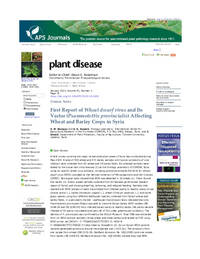First Report Of Wheat Dwarf Virus And Its Vector (Psammotettix Provincialis) Affecting Wheat And Barley Crops In Syria

Authors:
A field survey covering the major cereal-production areas of Syria was conducted during May 2009. A total of 938 wheat and 971 barley samples with typical symptoms of viral infection were collected from 45 wheat and 58 barley fields. All collected samples were tested by the tissue-blot immunoassay (1) at the Virology Laboratory of ICARDA, Syria using six specific cereal virus antisera, including polyclonal antibody AS-0216 for Wheat dwarf virus (WDV) provided by the German Collection of Microorganisms and Cell Cultures (DSMZ). Serological tests showed that WDV was detected in 16 wheat (cv. Cham 8) and five barley (cv. Arabic abiad) samples collected from Al-Hasskah governorate (eastern region of Syria) and showing dwarfing, yellowing, and reduced heading. Samples that reacted with WDV antiserum were transmitted from infected plants to healthy plants of oat (Avena sativa L.), barley (Hordeum vulgare L.), wheat (Triticum aestivum L.), and some grass species using four different leafhopper species, collected from Syrian wheat and barley fields, in a persistent manner. Leafhopper transmission tests indicated that only Psammotettix provincialis Ribaut was able to transmit Syrian barley WDV isolates (SB 1248-09 and SB 1249-09) from infected barley plants to healthy barley (48 plants became infected of 50 plants inoculated) and oats (45 of 50) under greenhouse conditions. The identity of P. provincialis was confirmed by the British Museum. Total DNA was extracted from six WDV-positive samples (three wheat and three barley) and tested by PCR using WDV primer set (WDV-F: 5'-TTGAGCCAATCTTCGTC-3'; WDV-R: 5'-GGAAAGACTTCCTGGGC-3') described by Oluwafemi (2). All six Syrian WDV-positive samples generated amplicons around the expected size (~253 bp). The amplicons from one isolate from wheat (SW 2131-09, GenBank Accession No. HQ113095) and one isolate from barley (SB 1248-09, GenBank Accession No. HQ113096) showed they had 86% sequence identity with each other, suggesting that both isolates can be considered to belong to the same species (3). Barley isolate SB 1248-09 had 99% sequence identity to an Iranian isolate of Barley dwarf virus (FJ620684.1) and 92% identity to most European barley-WDV isolates (e.g., Germany [AM942044.1] and Hungary [FM999832.1]), whereas, the wheat isolate (SW 2131-09) had 98 to 100% identity with most European wheat-WDV isolates (e.g., Czech Rep [FJ546191.1] and Germany [AM296023.1]) and a Chinese isolate (EF536868.1). WDV has been reported to infect cereals in few countries in West Asia and North Africa (Turkey, Tunisia, and Morocco) and causes economic losses on wheat in many countries in Europe (e.g., Sweden). WDV has been reported to be transmitted in a persistent manner only by leafhoppers (P. alienus Dahlbom) (4) to a wide range of cereal and wild grasses. Two strains of WDV are known, one that primarily infects wheat and another that infects barley. To our knowledge, this is the first record of WDV (both strains) infecting wheat and barley crops in Syria and the first report of P. provincialis as a WDV vector worldwide.
